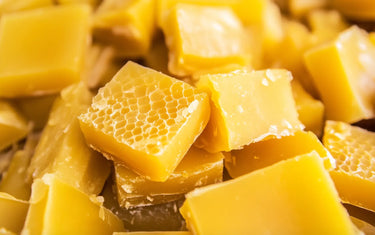8 min read / 19 February 2024 / yasmin sharp
8 Benefits of Grapeseed Oil for Skin
Discover the transformative skin benefits of grapeseed oil, from acne treatment to hydration and sun protection.
Share this post

Most people enjoy a good grape. Whether it’s as a delicious fruit, crushed into wine, dried up into a raisin or processed into jam, they seem to find a way into most people’s diets.
But did you know that grapeseed oil can also offer a host of benefits for skin?
It can be used on its own as a carrier oil, or as a foundation for essential oils, opening up a whole new world of skincare treatments.
But what are the benefits of grapeseed oil for skin and what kind of hidden properties could be useful for our day-to-day lives? To shed some light, we break down everything you need to know.
What is grapeseed oil?Grapeseed oil (Vitis Vinifera) is a plant-based carrier oil extracted from the seeds of the common grape. The seeds are cold pressed to create a pale yellow to green coloured oil with a light, mildly sweet scent. The oil’s high smoke point allowed it to originally gain popularity as a cooking ingredient. When researchers discovered the presence of a compound called pycnogenol in the oil, it started to appear in a wider range of skincare products like serums, moisturisers and toners. |

What are the benefits of grapeseed oil for skin?
The varied benefits of grapeseed oil for skin mean it could be used to:
1. Treat acne breakouts and scars
Grapeseed oil is non-comedogenic, which means it could be used to not only prevent acne, but also to clean it too.
The oil’s antimicrobial properties work to combat harmful bacteria in skin pores to slowly remove blemishes over time.
Grapeseed oil is also rich in vitamin E and some studies have suggested that applying the oil to your skin twice a day for only two weeks could produce noticeable results. [1]
And during the inflammatory phase, the linoleic acid properties of grapeseed oil could help the repair process and lower the risk of scarring.
2. Produce a more even skin tone
As we mentioned above, the vitamin E content of grapeseed oil can be very beneficial for the skin, with its phenolic compounds and fatty acids helping to clear scarring to create a more even skin tone.
This was suggested as one of the benefits of grapeseed oil for skin in a 2004 study, with researchers concluding that it could tackle the symptoms of melasma – a type of hyperpigmentation often caused by pregnancy. [2]
Further examination of the oil has also discovered that it contains an antioxidant ingredient called proanthocyanidin, which may be able to even out your skin tone after application. [3]
3. Hydrate skin and reduce dryness
Another big benefit of vitamin E being present in grapeseed oil is that it can help to soften and hydrate the skin.
This is due to the nutrient’s ability to decrease inflammation and hold moisture in the skin barrier, with anecdotal evidence suggesting it could remain there for as long as 16 hours.
According to a 2018 study, grapeseed oil also has a high concentration of polyunsaturated fats, which could be the underlying force that provides its hydrating benefits. [4]
4. Protect the skin against sun damage and free radical damage
Like many other carrier oils, grapeseed oil is rich in antioxidants, which can offer protection for our skin.
The presence of antioxidants ensures that the benefits of grapeseed oil for skin may extend to reducing damage caused by free radicals, as well as environmental damage caused by pollution and UV exposure.
Vitamins C, D and E provide some of the strongest antioxidant protection, which researchers have demonstrated could safeguard skin against the effect of ultraviolet radiation. [5]
5. Boost collagen and bone strength
Collagen synthesis and bone formation could be improved through increased flavonoid consumption, which can be provided via grape seed extract (GSE).
GSE is rich in flavonoids, which some studies suggest may play a role in increasing bone strength and density.
For example, one animal study found that when GSE is added to a low, standard or high calcium diet, mineral content, bone density and bone strength can be increased. [6]
A separate animal study demonstrated that bone destruction in inflammatory autoimmune arthritis could also be suppressed. [7]
However, there are not enough human studies available to confidently state that this could have the same effect, so more research is required to understand its impact.

6. Inhibit infectious growth
Whilst studies have largely been focussed on animal subjects, test results indicated that GSE’s antifungal and antibacterial properties could be used to combat infections.
One study showed that the likes of Campylobacter and E. coli, which are often responsible for causing food poisoning, can be inhibited by GSE. [8]
In another study focussed on the treatment of mice with vaginal candidiasis (yeast infection), subjects were given an intravaginal GSE solution every other day across an 8-day period. [9]
After 5 days the infection was restrained and gone by the time the treatment had finished.
7. Enhance wound healing and appearance
Wound healing may be another one of the most important benefits of grapeseed oil for skin, with positive results also being demonstrated in human tests.
For example, a 2% cream or placebo was given to 35 healthy adults who had recently undergone minor surgery. [10]
Within 8 days, subjects that used the cream saw their wounds fully heal, whilst it took a total of 14 days for the placebo group to recover.
This disparity could be due to the presence of proanthocyanidins in GSE, which may help to instigate growth factors in the skin.
Another larger human study saw a 2% GSE cream administered to 110 healthy young men, which helped to improve skin elasticity, appearance and sebum content, which can reduce the signs of ageing. [13]
8. Provide antifungal protection for nails
The antifungal properties contained in GSE is often the reason why grapeseed oil is used as a carrier for nail treatments.
Its natural vitamin E properties help to moisturise the nail bed, which some believe strengthens brittle nails, whilst also helping to prevent flaking and splitting.
One suggestion could be to apply grapeseed oil to recondition your nails if gel nails or extended nail varnish have been in use for some time.

How to use grapeseed oil for skin
The many benefits of grapeseed oil for skin are derived from its versatility, which allows it to be used in a variety of ways, such as a:
- Body treatment: You can apply grapeseed oil directly to your skin after you have finished a shower or bath, leaving it to absorb and slowly improve its look and feel.
- Face moisturiser: Some people use grapeseed oil as an overnight treatment to moisturise dry skin. All you need to do is apply where needed before bed, leaving it to work through the night so your skin is hydrated and refreshed in the morning.
- Massage oil: Another popular option is to use grapeseed as a massage oil. This is because it’s lightweight and not too greasy, making it easy for hands or massage tools to move over the skin, whilst also providing a host of health benefits.
- Daily cleanser: Because grapeseed oil is a carrier oil, this means it works perfectly with an array of essential oils. When you find a combination that works for your skin, you add it to your skincare routine as a toner or daily cleanser.
What essential oils work well with grapeseed oil?
To get even more from grapeseed oil, you can combine with essential oils to further benefit your skin.
Essential oils are extracted from plants and flowers and are too potent to be used on our skin in pure form.
To make them more palatable for our skin, many people use carrier oils like grapeseed oil to reduce the risk of irritation or an allergic reaction.
Some essential oils that work great with grapeseed oil include:
You can also combine grapeseed oil with heavier carrier oils like argan oil or vitamin E, which can make it easier for them to absorb into the skin.
If you are new to the world of oils, our Ultimate Benefit Bundle offers the perfect match of three carrier oils and three essential oils, which can be used to improve wellness in your skin, hair and nails.
Is it safe to use grapeseed oil on your face?
Grapeseed oil is generally considered to be safe to use on the face, as its high absorption rate and non-comedogenic properties make it one of the safest carrier oils around.
This applies to all skin types – although if you have a known allergy you should look for an alternative oil to use.
If you are new to grapeseed oil, it is also a good idea to perform a small patch test before using it on larger areas of skin.

Frequently Asked Questions about Grapeseed Oil
Can grapeseed oil lighten skin?
Studies have shown that grapeseed oil can reduce signs of hyperpigmentation, as well as sunspots, scarring and other types of skin abrasions. [12]
Does grapeseed oil cause acne?
Grapeseed oil is naturally non-comedogenic, which means upon application it will not clog pores and is suitable for most people with acne to use on their skin.
Do I need to dilute grapeseed oil before use?
One of the most helpful benefits of grapeseed oil for skin is that you do not need to dilute it before topical application, as it is a very gentle carrier oil that can be applied directly to the skin.
Can I mix grapeseed oil with essential oils?
Grapeseed oil is a carrier oil, which means it is designed to help “carry” and dilute essential oils safely onto the skin to reduce the risk of irritation or allergic reactions.
When using an essential oil for the first time, it is always a good idea to perform a small patch test to ensure it is suitable for your skin.
[1] Nicola Zampieri et al. (2010) A prospective study in children: Pre- and post-surgery use of vitamin E in surgical incisions https://www.jprasurg.com/article/S1748-6815(09)00609-3/fulltext
[2] Jun Yamakoshi et al. (2004) Oral intake of proanthocyanidin-rich extract from grape seeds improves chloasma https://pubmed.ncbi.nlm.nih.gov/15597304/
[3] Supachai Yodkeeree et al. (2018) Skin Anti-aging Assays of Proanthocyanidin Rich Red Rice Extract, Oryzanol and Other Phenolic Compounds https://journals.sagepub.com/doi/10.1177/1934578X1801300812
[4] Tzu-Kai Lin et al. (2018) Anti-Inflammatory and Skin Barrier Repair Effects of Topical Application of Some Plant Oils https://www.ncbi.nlm.nih.gov/pmc/articles/PMC5796020/
[5] Radava R. Korać et al. (2011) Potential of herbs in skin protection from ultraviolet radiation https://www.ncbi.nlm.nih.gov/pmc/articles/PMC3263051/#__ffn_sectitle
[6] N Yahara et al. (2005) Mechanical assessment of effects of grape seed proanthocyanidins extract on tibial bone diaphysis in rats https://pubmed.ncbi.nlm.nih.gov/15951633/
[7] Jin-Sil Park et al. (2012) Grape-seed proanthocyanidin extract as suppressors of bone destruction in inflammatory autoimmune arthritis https://pubmed.ncbi.nlm.nih.gov/23251512/
[8] Jose Manuel Silvan et al. (2016) Grape seed extract (GSE) modulates campylobacter pro-inflammatory response in human intestinal epithelial cell lines https://www.tandfonline.com/doi/full/10.1080/09540105.2017.1312292
[9] Giovanna Simonetti et al. (2014) Evaluation of Anti-Candida Activity of Vitis vinifera L. Seed Extracts Obtained from Wine and Table Cultivars https://www.ncbi.nlm.nih.gov/pmc/articles/PMC4017847/
[10] Ali Asghar Hemmati et al. (2014) The topical effect of grape seed extract 2% cream on surgery wound healing https://pubmed.ncbi.nlm.nih.gov/25948437/
[12] Jun Yamakoshi et al. (2004) Oral intake of proanthocyanidin-rich extract from grape seeds improves chloasma https://pubmed.ncbi.nlm.nih.gov/15597304/
[13] A Sharif et al. (2015) Formulation and evaluation on human skin of a water-in-oil emulsion containing Muscat hamburg black grape seed extract https://pubmed.ncbi.nlm.nih.gov/25402429/









